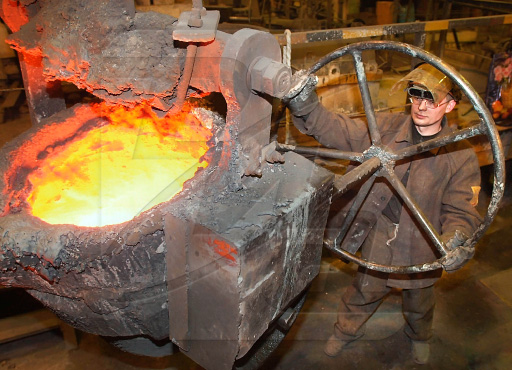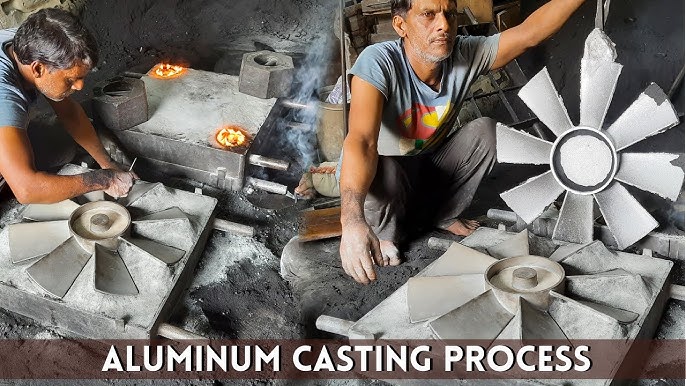Aluminum Foundry Wisconsin drives sustainable casting practices
Exactly How Aluminum Foundry Adds To Improvements in Aerospace Design
Aluminum foundries are indispensable to advancements in aerospace engineering. They produce light-weight, high-strength components that are essential for modern-day aircraft. Via sophisticated casting techniques, these shops produce intricate geometries that improve architectural stability. Additionally, the development of remarkable Aluminum alloys supports the market's focus on fuel efficiency and sustainability. Difficulties continue to be in the manufacturing procedure. Understanding these elements reveals the extensive influence of Aluminum on air travel's future.
The Importance of Lightweight Products in Aerospace Style
As the aerospace sector continues to develop, the value of light-weight products becomes increasingly apparent. The need for efficiency and sustainability drives engineers to focus on making use of products that reduce general weight without compromising structural honesty. Light-weight products, specifically Aluminum, play a necessary role in improving fuel effectiveness, enhancing haul ability, and enhancing the overall efficiency of airplane.
Furthermore, the integration of these products enables ingenious designs, allowing suppliers to create even more wind resistant shapes that can stand up to extreme conditions. The reduction in weight not only lowers operational costs but likewise adds to a reduced environmental impact, straightening with international initiatives towards sustainability in air travel.
Advanced Casting Techniques in Aluminum Foundries
Advanced spreading techniques in Aluminum shops play a vital role in aerospace design by allowing the production of light-weight and exact components. Advancements in mold style and precision casting processes are vital in attaining perfect performance and architectural stability. Additionally, the development of light-weight alloys improves the overall effectiveness and effectiveness of aerospace applications.
Innovative Mold And Mildew Design
Cutting-edge mold and mildew style plays an important role in the effectiveness and efficiency of Aluminum foundries, specifically within the aerospace market. By leveraging sophisticated materials and strategies, modern mold and mildews can be engineered to withstand heats and pressures, ensuring peak efficiency throughout the spreading process. These layouts frequently include complex geometries that permit the manufacturing of lightweight yet structurally audio components, important for aerospace applications. In addition, the usage of computer-aided layout (CAD) software application facilitates exact modeling, making it possible for foundries to refine and replicate mold and mildew layouts before physical manufacturing starts. This not only improves the high quality of actors parts but likewise lowers waste and preparation, causing substantial cost savings. On the whole, ingenious mold style is a keystone of progress in Aluminum Foundry innovation for aerospace design.
Precision Casting Procedures
The performance of cutting-edge mold and mildew designs seamlessly integrates with precision casting processes, which are vital for generating high-quality Aluminum elements in aerospace engineering. These processes, including sand casting, pass away casting, and investment spreading, assure the creation of complex geometries with tight resistances. Advanced strategies like vacuum cleaner spreading and stress die casting boost the honesty and surface area finish of the end products. Precision casting reduces material waste while maximizing the mechanical properties of Aluminum, critical for aerospace applications. In enhancement, using real-time surveillance and progressed simulation devices throughout the casting process enables prompt adjustments, resulting in enhanced quality control. Collectively, these precision casting procedures placement Aluminum factories at the leading edge of aerospace technology, sustaining the market's demand for reliability and performance.
Light-weight Alloy Growth
As aerospace engineers look for to boost fuel effectiveness and performance, light-weight alloy development becomes a vital emphasis in Aluminum shops. These shops employ innovative spreading techniques to create alloys that provide premium strength-to-weight ratios. Developments in alloy make-up, including the unification of components like lithium and magnesium, make it possible for the production of products that stand up to severe conditions while minimizing total aircraft weight. Strategies such as die spreading and financial investment casting facilitate the accuracy manufacturing of complex forms, which are important for aerospace applications. Additionally, continuous study aims to optimize these alloys for improved mechanical buildings and enhanced longevity. By prioritizing light-weight alloy growth, Aluminum foundries substantially add to the evolution of aerospace design, leading the way for more sustainable and reliable aircraft styles.

Enhancing Architectural Honesty With Aluminum Components
Aluminum components provide substantial advantages in enhancing structural honesty within aerospace engineering. Their lightweight nature adds to overall performance while maintaining strength, which is crucial for airplane performance. Furthermore, the anxiety resistance homes of Aluminum assistance ensure the resilience and dependability of aerospace structures under different operational conditions.
Light-weight Product Advantages
While conventional materials frequently jeopardize weight for strength, using Aluminum parts in aerospace design supplies substantial benefits in architectural integrity. Aluminum's lightweight nature adds to overall style efficiency, permitting even more streamlined aircraft that take in less gas, thus improving sustainability. The material's superb strength-to-weight proportion warranties that elements maintain resilience without adding unnecessary mass. This quality fosters enhanced performance and dexterity in flight, have a peek here along with enhanced haul capabilities. Furthermore, Aluminum's resistance to corrosion prolongs the lifespan of aerospace structures, minimizing maintenance prices and boosting security. As producers significantly embrace Aluminum alloys, the aerospace industry experiences a transformative change in the direction of extra reliable and reliable design remedies that prioritize both efficiency and ecological responsibility.
Tension Resistance Properties
Various materials possess distinct residential properties, Aluminum's extraordinary stress and anxiety resistance stands out as an essential factor in enhancing the structural stability of aerospace elements. This resistance plays an essential function in ensuring that aircraft can stand up to different functional stress and anxieties, including tiredness, effect, and environmental problems. Aluminum alloys, especially crafted for aerospace applications, show high tensile toughness while keeping lightweight characteristics, enabling engineers to design more effective frameworks - Aluminum Foundry. Furthermore, the capability of Aluminum to endure cyclic loading without substantial contortion adds to the longevity and reliability of aerospace elements. As advancements proceed in Aluminum Foundry strategies, the development of stress-resistant Aluminum elements guarantees additional improvements in efficiency, safety, and effectiveness throughout the aerospace industry, solidifying Aluminum's role as a recommended product in contemporary engineering
Gas Effectiveness Improvements Driven by Aluminum Innovations
As the aerospace sector looks for to improve gas effectiveness, innovative usages of Aluminum have arised as an essential service. Aluminum's light-weight nature notably lowers aircraft weight, permitting reduced gas consumption during flight. This decrease in weight is important, as also small declines can bring about significant improvements in general fuel economic situation.
Advanced Aluminum alloys, created for enhanced toughness and durability, make it possible for suppliers to create parts that maintain architectural stability while lessening mass - Aluminum Foundry. Additionally, the integration of Aluminum in airframes and engine elements promotes enhanced the rules of aerodynamics, adding to minimized drag and boosted performance
The adoption of Aluminum in aerospace not just meets the need for fuel-efficient style yet also lines up with governing pressures for lower exhausts. As these advancements continue to progress, they play a significant role in setting brand-new standards for fuel efficiency, making certain that the aerospace sector can meet expanding ecological and financial difficulties.

The Role of Aluminum in Sustainable Aviation Practices
The enhancing emphasis on lasting air travel methods has actually placed Aluminum as an essential material in the mission for greener aircraft layout. Understood for its lightweight buildings, Aluminum substantially lowers aircraft weight, bring about lower gas intake and exhausts. Its recyclability better enhances its sustainability profile, as Aluminum can be reused forever without loss of top quality. This particular supports a circular economy within the aviation sector, reducing waste and source deficiency.
In addition, innovations in Aluminum alloys have actually enhanced their strength and corrosion resistance, permitting longer service life and reduced upkeep requirements. These technologies promote the advancement of much more reliable aircraft frameworks, adding to overall sustainability initiatives. Additionally, Aluminum's thermal conductivity plays an important duty in energy-efficient styles, boosting systems such as warmth exchangers. Jointly, these qualities highlight Aluminum's critical function ahead of time sustainable aviation, lining up with international campaigns aimed at minimizing the environmental influence of flight.
Challenges Faced by Aluminum Foundries in Aerospace Manufacturing
While Aluminum foundries play a necessary function in aerospace manufacturing, they deal with substantial difficulties that can affect production effectiveness and high quality. One significant challenge is the rigorous quality control requirements required in the aerospace market. Any kind of defect can jeopardize safety and security and performance, demanding rigorous examination procedures that extend production timelines. In addition, foundries usually contend with fluctuating basic material more tips here expenses, which can impact prices and productivity. The intricacy of Aluminum alloys utilized in aerospace applications more makes complex the manufacturing procedure, as specific formulations are critical for achieving preferred mechanical residential properties. Moreover, knowledgeable labor scarcities hinder the ability to preserve high-grade manufacturing levels. Ultimately, ecological laws enforce constraints on emissions and waste administration, needing factories to invest in sustainable practices, which can be cost-prohibitive. These elements collectively create a landscape where Aluminum foundries should continuously adjust to meet the progressing demands of aerospace production while ensuring security and conformity.
Future Patterns in Aluminum Applications for Aerospace Engineering
With improvements in innovation and increasing needs for effectiveness, the future of Aluminum applications in aerospace engineering is positioned for considerable makeover. The combination of innovative Aluminum alloys and composites is anticipated to improve strength-to-weight ratios, leading to even more fuel-efficient aircraft styles. On top of that, advancements in additive production methods will enable the production of intricate Aluminum structures that were formerly impossible, maximizing performance and lowering waste.

Sustainable methods will certainly play a vital role, with an expanding emphasis on recycling Aluminum to reduce ecological influence. The aerospace industry is most likely to accept smarter producing procedures, such as automation and expert system, ensuring better and precision in Aluminum components. Furthermore, collaborations between Aluminum factories and aerospace firms will certainly cultivate r & d, leading the means for brand-new applications that fulfill the rigorous needs of modern aerospace engineering - Aluminum Foundry. Overall, the future looks promising for Aluminum's role fit the skies
Regularly Asked Concerns
What Are the Ecological Effects of Aluminum Production in Aerospace?
The environmental impacts of Aluminum production in aerospace consist of substantial power usage, greenhouse gas emissions, and environment disturbance. Furthermore, mining processes can result in soil destruction and water contamination, increasing worries regarding sustainability and environmental balance.
Just How Does Aluminum Contrast to Other Products in Aerospace Applications?
Aluminum uses a special mix of lightweight residential or commercial properties, corrosion resistance, and cost-effectiveness contrasted to other products. Its high strength-to-weight ratio makes it specifically useful for aerospace applications, improving gas effectiveness and general performance in airplane design.
What Credentials Do Aluminum Foundry Workers Need for Aerospace Projects?
Aluminum Foundry employees require specific training in metallurgy and casting techniques, together with knowledge of aerospace market standards. Certifications in quality assurance and security methods are likewise important to assure conformity with stringent aerospace job needs.
Are There Any Security Interest In Utilizing Aluminum in Aerospace Design?
Safety problems relating to Aluminum in aerospace design consist of vulnerability to tiredness, corrosion, and stress and anxiety cracks. Proper treatment and alloy selection are vital to alleviate these threats, ensuring structural stability and general safety in aerospace applications.
How Does Aluminum Recycling Benefit the Aerospace Market?
Aluminum reusing greatly benefits the aerospace industry by minimizing product prices, decreasing ecological impact, and conserving energy. This sustainable technique boosts the sector's performance while advertising the use of lightweight, high-performance parts in aircraft production.
Advanced casting methods in Aluminum shops play an essential duty in aerospace engineering by enabling the production of lightweight and precise parts. Innovative mold style plays a necessary function in the effectiveness and effectiveness of Aluminum factories, particularly within the aerospace market. As aerospace engineers seek to enhance fuel performance and efficiency, lightweight alloy advancement comes to be an essential emphasis in Aluminum factories. Aluminum alloys, specifically crafted for aerospace applications, display high tensile stamina while preserving light-weight attributes, enabling engineers to develop extra efficient structures. Cooperations in between Aluminum foundries news and aerospace companies will certainly foster study and development, leading the way for new applications that meet the rigorous demands of contemporary aerospace design.